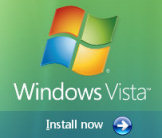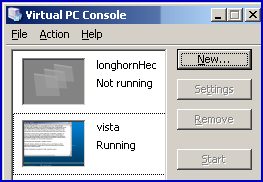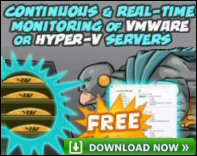Installing Vista on Microsoft Virtual PC
Which ever version of Windows Vista you have, this page will help you install it on Microsoft Virtual PC.
Topics for Installing Vista on Virtual PC
- Introduction to Installing Windows Vista on Virtual PC
- First Goal – Get a Copy of the Vista Build
- Second Goal – Create a Simple Microsoft Virtual PC
- Third Goal – Capture the CD – Use Physical Drive
- Fourth Goal – Create a Partition for the Vista Install
- Post Installation and Virtual Machine Additions
- Troubleshooting the Actual Vista Installation
I also have instructions for older Vista builds, they are probably obsolete, but just in case that is the only version you have, here are the references: 5600,5536,5472, 5456, 5308,5270 and 5112. Onward! Windows 8 Build 8102.
Please note: here is an update featuring Windows Virtual PC 2007 SP1
N.B. For Windows Server 2008 there isHyper-V virtualization
♦
Introduction to Installing Windows Vista on Virtual PC 2004
From the outset, I believed that it would be possible to install Vista on Microsoft’s Virtual PC 2004**. My previous experience is that I have installed about 25 virtual machines before I installed Vista. I choose to install Virtual PC 2004 on Windows Server 2003, even though the setup says explicitly that this host operating system is not recommended. The reason that I mention these two facts is to give you confidence. I want to emphasise that while I am no great expert on Virtual PC, I still got Vista working. I would also like to report that installing the final release of Vista on Virtual PC is easier than the beta versions.
**The latest version of Microsoft Virtual PC is 2005. While it looks flashy, has more features, I just cannot get along with version 2005, principally because every time I do anything it asks for my username and password Virtual PC 2004 rarely annoys me in this way.
For experienced techies, who are geniuses at computing, all you need to do is absorb these key concepts:
- Obtain your copy of Vista, either on DVD or as an image.
- Create a new Virtual Machine with Virtual PC.
- Capture the DVD drive or the image of the Vista in the Virtual Machine.
- Have patience and faith that the Vista install will work.
For ordinary mortals, I will provide step-by-step instructions to help you install Vista on Virtual PC.
First Goal – Get a Copy of the Windows Vista
Now that Microsoft has released Vista, getting a copy is only a matter of paying your money! The rest of this paragraph is to tempt you to apply for Microsoft’s CPP for future releases such as Longhorn. Long term, it would be useful for you to sign up for the Beta CPP (Customer Preview Program), however, they keep changing the procedure, thus you need to contact Microsoft, not me, for the Vista software. One of Microsoft’s satellite companies called Connect deals with Beta downloads. You can find them at connect.microsoft.com.
The Actual Vista image
When you select your Vista image, make sure that you have the appropriate version for your x86 or x64 processor. It is always worth reading every software’s Release Notes. There was a message in my notes of a problem redirecting plug and play devices with Terminal Services. Earlier the Vista Beta release notes helpfully informed readers that there would be an upgrade path from Vista RC2 to future builds including an upgrade to the release version.
Second Goal – Create a Simple Microsoft Virtual PC
My advice is keep the New Virtual PC setup as simple as possible, just follow the defaults; the one exception is increase the memory for your Vista Virtual Machine from 512 to 1GB. By all means adjust the other settings once you have created the machine and installed the operating system.
- From the Virtual PC Console, click New…
- Create a virtual machine.
- Choose a location with at least 16 GB of free space.
- Operating System, Other or Windows Server 2003 it doesn’t matter.
- Adjusting the Ram – 512 MB Ram is recommended, I choose 1,050 MB.
- A new virtual hard disk.
- Name and Location. Previously, I created a special partition (V:\) on my host machine for VM images.
- Finish.
Third Goal – Capture the CD – Use Physical Drive
If you have a copy of Vista on DVD, then you can skip this step. Else this is the situation so far, we have obtained the ISO DVD image, now we want to boot the Virtual Machine. The problem is that we want to boot, not from the physical CD, but from the bootable ISO image.
Nero’s ImageDrive
There is problem with booting Virtual machines using Vista ISO images, this started with Vista build 5308 and includes the final release version. These ISO images are over the 2.2 GB DVD limit that Virtual Machine 2004 understands. (Build 5270 was under 2.2 GB). For me the solution was to invest $48 in Nero 7. From Nero 7’s many utilities, I selected ImageDrive. What Nero ImageDrive does is make the ISO image appear as a Physical drive, as a result you can by-pass the ‘Capture ISO Image’ which has the 2.2 GB limit.
What ImageDrive did for me was capture the en_windows_vista_x86_dvd_X12-34293.iso to the I: drive. (Your drive letter is likely to be E: F: or G:). The upshot is that you see a new drive letter in both Windows Explorer and in the Virtual Machine console.
What we do in the Virtual PC console, is click on the top menu called ‘CD’ and select – Use Physical Drive I: (See screen shot, but bear in mind that your drive letter will be different from mine.)
Guy Recommends: A Free Trial of the Network Performance Monitor (NPM) v11.5
v11.5
SolarWinds’ Orion performance monitor will help you discover what’s happening on your network. This utility will also guide you through troubleshooting; the dashboard will indicate whether the root cause is a broken link, faulty equipment or resource overload.
What I like best is the way NPM suggests solutions to network problems. Its also has the ability to monitor the health of individual VMware virtual machines. If you are interested in troubleshooting, and creating network maps, then I recommend that you try NPM now.
Download a free trial of Solarwinds’ Network Performance Monitor
Fourth Goal – Create a Partition and Install Vista
My next step was to capture the I: drive to my DVD image (courtesy of Nero ImageDrive). Once Vista booted in the virtual machine, it asked for the Locale, I selected United Kingdom. The first few menus were straightforward, the only slight hiccup was obtaining the correct product Key. It seem that there is just one DVD (or Image) for all editions, Ultimate, Home Premium and the other 4 editions. What makes the difference is the product key that you type. To summarise, Vista Ultimate has a different product key from Vista Home basic, even though both could be installed using the same DVD / Image.
Earlier beta versions gave me enormous frustration when Windows Install asked the question ‘Where do you want to install Windows’, however, both Vista RC2 and the final production version, both handled creating the virtual disk smoothly. (Problems with Build 5308)
Once I clicked on Microsoft’s licence agreement, the install continued expanding cabinets, copying files and installing Vista’s default features, I came back 30 minutes later and found that the Windows Install had completed successfully.
At the end of the install, Vista asks you to set the Region and Time Zone. Another bonus was that Vista recognised the United Kingdom keyboard layout that I specified at the beginning of the install.
In terms of efficiency and intelligence, Vista has Microsoft’s best install technology to date. For example, XP installs are a pain, in that they halt after about 10 minutes and ask you to input networking information.
At the end of all the copying and configuring Vista asks you for a username and password. It then asks for the current use of the machine so that Vista can optimises the settings for home, work or a public location. Vista appeared to automatically detect the network and give itself, not an APIPA, but a suitable IP address for the subnet where I installed e.g. 192.168.0.10. This was not magic, it picked up the IP address from an XP machine with Internet Sharing. The Business Edition obtained an IP address smoothly from a traditional Windows DHCP server.
When you decide to install Windows Vista on a Virtual Machine, don’t be in a hurry. Have a good book to read, or a T.V. program to watch. The install takes 40 minutes and while there are long intervals where no human input is required, the whole procedure slows up the host machine.
Guy Recommends : SolarWinds’ Free VM Monitor
The best feature of this new this new version of SolarWinds VM Monitor is that it checks Windows Hyper-V. Naturally, it still works with virtual machines on VMware ESX Servers. VM Monitor is a clever desktop tool that not only tests that your server is online, but also displays the CPU and memory utilization for each node.
It’s easy to install and to configure this virtual machine monitor, all you need the host server’s IP address or hostname and the logon info. Give this virtual machine monitor a try – it’s free.
Download your free copy of SolarWinds VM Monitor.
Post Installation Tasks and Virtual Machine Additions
Creating an Administrator Account.
A new development when installing Vista is the need to create the administrator’s account, as a security initiative, Microsoft no longer create a person called ‘Administrator’ by default.
Vista Activation Tip:
If you are installing Vista just to test the features, or out of curiosity, un-check the Activate Online box. My point is that you can legitimately conserve your activation lives. The situation with my genuine MSDN Vista product key is that it can be used up to 10 times. (However other product keys may have different activation properties.) What I suggest is you start with a non-activated installation, then after say a week, either choose to activate your licence online, or re-install with a bigger partition and activate that installation.
Virtual Machine Additions
When the the earlier Vista builds finished installing, I was disappointed. In 5308, the 256 color resolution meant an atrocious display of any graphics moreover, the machine ran unacceptably slowly – even for Beta software. Then I remembered the Virtual Machine Additions. In a nutshell installing this add-on transformed my Vista Beta experience.
Try SolarWinds Virtualization Manager »
Vista final release
With Vista I learnt from this experience and attempted, emphasise attempted, to add the Virtual Machine Additions before I started the install. Therefore, I was slightly surprised when later the Virtual PC kept asking me to install the Virtual Machine Additions.
To install the Virtual Machine Additions – again, I launched the Virtual PC console and clicked the ‘Action’ Menu and selected, ‘Install the Virtual Machine Additions’. It seemed to install very quickly – too quickly. To cut a long story short, this procedure was useless, the machine kept prompting me to install the Virtual Machine Additions. 
Solution to Install Virtual Machine Addition on RC2
Finally, I went for the throat. I allowed the Virtual PC switch the D:\ to the Virtual Machine Additions, but then I took over manually and drilled to D:\windows\ and double clicked setup. From here the Setup InstallShield Wizard appeared, took its time, but installed the Virtual Machine Additions properly.
What lulled me was the fact that Vista had good graphics from the start and silly me thought the slow performance was down to a checked beta version, the reality was the slow performance was down to lack of Virtual Machine Additions.
Solution to Install Virtual Machine Additions on a Production Version of Vista
Install the Virtual Machine Additions ‘by the book’, click on the file menu, Install Virtual Machine Additions, just ‘Continue’ when the UAC (User Account Control) dialog box prompts you. I will probably never know if my experience with the previous build was user error or a beta bug. Beta testing is like that, stuff happens and I am not sure who to blame, me or Vista Beta.
Further Post Installation Tasks
I found that the best setting for Network Adapter1 was to select the host NIC. In particular, this configuration cured a specific problem: Virtual PC could not open the Virtual Machine Network Services driver, or The Virtual Machine Network Services driver has failed to install.
My machine was fortunate in having 2 GB of Ram, so I allocated 1 GB to Vista. The problem was the Virtual PC Console would not let me use more than 300 MB. The error was: The virtual machine could not be started because there was not enough memory available on the host.
The true problem was interference from other programs, in my case Nero CD burner, in another case SQL. Therefore, try judicious zapping images in Task manager until you find the root cause, I say again, take care ending processes. The safe way would be to remove programs via the Add or Remove Programs.
Footnote
The above problem did not occur with Vista (only Beta 5270). I credit Microsoft for ironing out that behaviour, however, it could have been the fact that I upgraded from Nero 6 to Nero 7.
![]() Once you have installed Vista in your virtual machine, access it via Remote Desktop from your host machine.
Once you have installed Vista in your virtual machine, access it via Remote Desktop from your host machine.
Extra info kindly sent by ‘Trombone’
Installed Vista in VPC04
Installed the VPC04 additions.
Rebooted.
Vista ran slowly to me.
In Vista, installed VS05 (I didn’t want to clutter the host OS with software I wasn’t going to use).
Dug through the program files and grabbed the VM Additions ISO from the VS05 install
Dragged file off of Vista and onto XP host
Uninstalled the VPC04 additions from Vista
Rebooted
Vista ran very slowly without any additions.
Mounted the ISO as a drive and installed the latest Additions (that came from VS05).
Rebooted
Wow, Vista ran very quickly on my system and went from a struggle of sit and wait to actual usability.
Troubleshooting the Actual Vista Installation
Firewall Problem. I am assuming that your hardware is up to specification, but you still have a problem with your Vista installation. One problem that I encountered was when I tried to join a domain only for the firewall on the server to block the vital ports. I should have research which ports to open, but I just disabled the firewall for enough time for the Vista machine to join the Active Directory Domain.
Proxy Server Activation Problem. If you try to activate the Windows Vista only to get error code 0x8004FE33, then I would phone the automated phone system as directed by the Windows Activation Wizard. The cause of this error is a proxy server which is configured to use only basic authentication, thus you could try disabling basic authentication on the proxy server.
Dirty DVD Disk. If you get a file copying problem during installation it may be dust or dirt on the DVD. I use a clean hanky or a shirt tail, but your supposed to use a clean cloth. Scratches are more difficult, however you may find that Microsoft will replace the disk for free, after all it’s the product key that counts.
If all else fails call in the experts installers: Install Any Operating System – Everything you need to know to install Windows, Mac or Linux and the software to make them functional.
Summary of Installing Windows Vista in a Virtual PC
Obtain your copy of Windows Vista by either on DVD (best) or by downloading an Image from connect.microsoft, or MSDN if you subscribe to those Microsoft satellite services. Launch the Virtual Machine console to create a new Virtual disk / image / machine. Capture the image from the CD menu. The actual installation takes about half an hour, but the menus are straightforward, even easy if you have experience from installing XP.
If you like this page then please share it with your friends
Preparing for Windows Vista Topics:
- Overview of Windows Vista
- 12 New Features of Windows Vista
- More New Features in Vista
- Vista Upgrade Advice
- Windows Vista Hardware Assessment (WVHA)
- Vista Versions / Editions
- Vista Hardware Considerations
- How to Install Vista
- How to Install Windows Vista on Virtual PC
- Vista Screen Shots
- Vista SP2
- IE 8 Review
- Check Performance with ipMonitor
- Vista Jokes!





